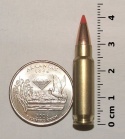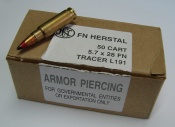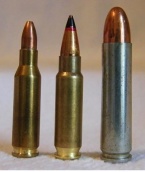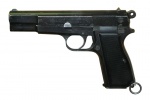5.7x28mm
| 5.7x28mm | ||||||||||||||||
|---|---|---|---|---|---|---|---|---|---|---|---|---|---|---|---|---|
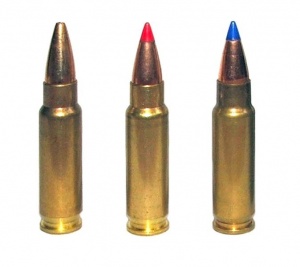
| ||||||||||||||||
| 5.7x28mm sporting cartridges. From left to right: SS195LF, SS196SR, and SS197SR. | ||||||||||||||||
| Type | PDW cartridge | |||||||||||||||
| Country of Origin | Belgium | |||||||||||||||
| Specifications | ||||||||||||||||
| Case Type | Rimless, bottleneck | |||||||||||||||
| Bullet Ø | 5.7 mm (0.224 in) | |||||||||||||||
| Neck Ø | 6.35 mm (0.25 in) | |||||||||||||||
| Shoulder Ø | 7.9 mm (0.311 in) | |||||||||||||||
| Base Ø | 7.9 mm (0.311 in) | |||||||||||||||
| Rim Ø | 7.80 | |||||||||||||||
| Rim Thickness | 1.14 mm (0.045 in) | |||||||||||||||
| Case Length | 28.83 mm (1.135 in) | |||||||||||||||
| Full Length | 40.50 mm (1.594 in) | |||||||||||||||
| Rifling twist | 228.6 mm (1:9 in) | |||||||||||||||
| Primer | Boxer Small Rifle | |||||||||||||||
| Max. pressure | 345.0 MPa (50,040 psi) | |||||||||||||||
| Production & Service | ||||||||||||||||
| Designer | Jean-Paul Denis & Marc Neuforge (SS90) [1] | |||||||||||||||
| Design Date | 1986-90 (SS90) [2], '92-93 (SS190) [3] | |||||||||||||||
| Manufacturer | FN Herstal | |||||||||||||||
| Production Dates | 1990-93 (SS90)[3], 1993-present (SS190)[3] | |||||||||||||||
| Variants | See Varieties | |||||||||||||||
| In Service | 1991-present [2] | |||||||||||||||
| Used By | ||||||||||||||||
| Wars | First Gulf War, Afghanistan War, Iraq War, "Mexican drug war" [4] | |||||||||||||||
| Ballistic Performance Sampling | ||||||||||||||||
| ||||||||||||||||
In 2002 and 2003, NATO conducted a series of tests with the intention of standardizing a PDW cartridge as a replacement for the 9x19mm Parabellum cartridge.[7] The tests compared the relative merits of the 5.7x28mm cartridge and the 4.6x30mm cartridge, which was created by Heckler & Koch as a competitor to the 5.7x28mm.[7] The NATO group subsequently recommended the 5.7x28mm cartridge, citing superior performance in testing, but the standardization process was indefinitely halted.[7]
By 2006, FN's 5.7x28mm firearms—the P90 personal defense weapon and Five-seven pistol—were in service in over 40 countries throughout the world in various police or military roles.[8] In the United States, 5.7x28mm firearms are currently used by numerous law enforcement agencies, including the Secret Service.[9][10]
In addition to being used in the FN P90 and FN Five-seven, the 5.7x28mm cartridge has subsequently been used in the AR-57 and FN PS90 carbine.[11][12] Excel Arms is currently developing four firearms chambered in 5.7x28mm,[13] and Savage Arms is developing two bolt action rifles chambered in 5.7x28mm.[14][15] The 5.7x28mm cartridge itself is offered in a number of varieties. The SS195LF and SS197SR varieties are currently offered to civilian shooters for use in 5.7x28mm firearms.[16]
Contents |
[edit] History
The 5.7x28mm cartridge was designed in conjunction with the FN P90 personal defense weapon (PDW) and FN Five-seven pistol, in response to NATO requests for a replacement for the 9x19mm Parabellum cartridge.[7][17] The original 5.7x28mm cartridge, called the SS90, was introduced in 1990.[17] It used a 1.5-g (23 gr) plastic-core projectile which it propelled at a muzzle velocity of roughly 850 m/s (2,800 ft/s) when fired from the P90.[17] A United States patent application for the projectile design used in the SS90 was filed by FN's Jean-Paul Denis and Marc Neuforge in 1989.[1] U.S. Patent 5,012,743 ("High-Performance Projectile") was received in 1991.[3]
The 5.7x28mm SS90 cartridge was discontinued, and replaced in 1993 with the 5.7x28mm SS190.[3] The SS190 uses a 2.7-mm (0.11 in) shorter projectile with a weight of 2.0 g (31 gr), which it fires from the P90 at a muzzle velocity of roughly 715 m/s (2,350 ft/s).[18] The shorter length of the projectile allowed it to be more conveniently used in the 5.7x28mm FN Five-seven pistol, which was also being developed at that time.[3] A modified version of the P90 with a magazine adapted to use the shortened ammunition was introduced in 1993.[3] Several specialized 5.7x28mm varieties were also developed alongside the SS190, such as the L191 tracer round and the subsonic SB193 bullet for sound-suppressed use.[16] The 5.7x28mm FN Five-seven pistol then went into production in 1998.
In 2002 and 2003, NATO conducted a series of tests with the intention of standardizing a PDW cartridge as a replacement for the 9x19mm Parabellum cartridge.[7] The tests compared the relative merits of the 5.7x28mm cartridge and the 4.6x30mm cartridge, which was created by Heckler & Koch as a competitor to the 5.7x28mm.[7] The results of the NATO tests were analyzed by a group formed of experts from France, the United States, Canada, and the United Kingdom, and the group's conclusion was that the 5.7x28mm was "undoubtedly" the more efficient cartridge.[7]
Among other points, the NATO group cited superior effectiveness (27 percent greater) for the 5.7x28mm against unprotected targets and equal effectiveness against protected targets.[7] It also cited less sensitivity to extreme temperatures for the 5.7x28mm, and cited a greater potential risk of barrel erosion with the 4.6x30mm.[7] In addition, the group pointed out that 5.7x28mm is close to the 5.56x45mm NATO by its design and manufacture process, allowing it to be manufactured on existing production lines.[7] The group also pointed out that 5.7x28mm firearms are more mature than 4.6x30mm firearms, and that the 5.7x28mm FN Five-seven pistol was already in production at that time, while the 4.6x30mm Heckler & Koch UCP pistol was still only an early concept.[7] However, the German delegation and others rejected the NATO recommendation that 5.7x28mm be standardized, and as a result, the standardization process was indefinitely halted.[7][19]
In 2004, the SS192 hollow-point cartridge was introduced to civilian shooters alongside the new Five-seven IOM variant.[20] After being met with controversy, the SS192 variety was discontinued in the same year, and in 2005 the SS196SR variety was introduced using a 2.6-g (40 gr) V-Max projectile.[21][22] The SS196 was also shortly discontinued in favor of the newer SS195LF and SS197SR varieties, which are currently offered to civilian shooters for use in 5.7x28mm firearms, and the SS198LF variety, which is restricted by FN to law enforcement and military customers.[16]
In 2009, the National Rifle Association added 5.7x28mm firearms to its NRA Tactical Police Competition standards, allowing law enforcement agencies to compete in this event using 5.7x28mm firearms.
[edit] Design details
The 5.7x28mm cartridge was designed by FN specifically for use in the FN P90 personal defense weapon and FN Five-seven pistol.[5] Subsequently, it has been used in the FN PS90 carbine and the AR-57, an upper receiver for M16/AR-15 rifles.[11][12] The ST Kinetics CPW can also be configured for the 5.7x28mm cartridge, by changing the barrel and magazine groups. Excel Arms is currently developing four firearms chambered in 5.7x28mm,[13] and Savage Arms is developing two bolt action rifles chambered in 5.7x28mm.[14][15]
The 5.7x28mm cartridge weighs 6.0 g (93 grains),[23] roughly half as much as a typical 9x19mm Parabellum cartridge, allowing extra ammunition to be carried more easily.[24][25][26] The 5.7x28mm cartridge produces considerable muzzle blast and flash,[27] but it produces roughly 30 percent less recoil than the 9x19mm cartridge, improving controllability.[25][26] It also exhibits an exceptionally flat trajectory.[18][25]
One of the design intents of the SS190 variety of this cartridge (not sporting varieties) was that it have the ability to penetrate Kevlar protective vests, such as the NATO CRISAT vest, that will stop conventional pistol bullets.[26] Fired from the P90, the SS190 is capable of penetrating the CRISAT vest at a range of 200 m (655 ft).[26] It is also capable of penetrating a Level IIIA Kevlar vest at the same range.[18] However, sporting variants of the 5.7x28mm are classified as being not armor piercing by the U.S. Bureau of Alcohol, Tobacco, Firearms and Explosives (ATF).[21]
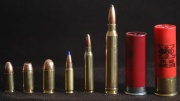
FN states that the 5.7x28mm has an effective range of 200 m (655 ft) and a maximum range of 1,800 m (5,905 ft) when fired from the P90,[28] and an effective range of 50 m (165 ft) and a maximum range of 1,510 m (4,955 ft) when fired from the Five-seven.[20] The SS190 and similar 5.7x28mm projectiles have been shown to turn base over point ("tumble") in testing in ballistic gelatin and other media, using the 21.6-mm (.85 in) projectile length[20] to create a larger wound cavity.[5][18][24][29][30] However, some are skeptical of the bullet's terminal performance, and it is a subject of debate among civilian shooters in the United States.[30]
The 5.7x28mm projectiles are statistically safer than others, because the projectile designs limit overpenetration and the projectiles have a low risk of ricochet.[29][31][32] Since the SS190 projectile does not rely on fragmentation or the expansion of a hollow point, the cartridge (and 5.7x28mm firearms) are considered suitable for military use under the Hague Conventions of 1899 and 1907, which prohibit use of expanding or fragmenting bullets in warfare.[30]
FN's 5.7x28mm brass cases are covered with a special polymer coating for easier extraction with the PS90 carbine due to the high chamber pressures and lack of case tapering.[24] In addition, the coating ensures proper feeding and function in the magazines.[24]
[edit] Cartridge dimensions
5.7x28mm maximum CIP cartridge dimensions. All sizes in millimeters (mm).
The 5.7x28mm has a cartridge case capacity of 0.90 ml (13.85 grains) H2O.[27]
Americans would define the shoulder angle at alpha/2 ≈ 35 degrees. The common rifling twist rate for this cartridge is 1:228.6 mm (1:9 in), 8 grooves, Ø lands = 5.53 mm, Ø grooves = 5.62 mm, land width = 1.63 mm and the recommended primer type is small rifle.[6][27]
According to the official Commission Internationale Permanente pour l'Epreuve des Armes à Feu Portatives (CIP) guidelines the 5.7x28mm case can handle up to 345 MPa (50,037 psi) piezo pressure.[27] In CIP-regulated countries every rifle cartridge combo has to be proofed at 125% of this maximum CIP pressure to certify for sale to consumers.
[edit] Varieties
- SS90 prototype
- The SS90 was an early prototype round used only in the earliest examples of the P90. It used a lightweight 1.5-g (23 grain) full metal jacket bullet with a polymer core, propelled at a muzzle velocity of roughly 850 m/s (2,800 ft/s). It was abandoned in 1994 in favor of the heavier and 2.7-mm (0.11 in) shorter SS190 projectile.[17]
- SS190 duty
- The SS190 FMJ, a refinement of the SS90, was introduced in 1993.[3] It offered superior performance over the prototype projectile as well as slightly reduced length.[3] The latter change allowed it to be used more conveniently in the Five-seven pistol also being developed at that time.[17] Fired from the P90, the SS190 propels a 2.0-g (31 grain) bullet at a muzzle velocity of roughly 715 m/s (2,350 ft/s). It has a steel penetrator and an aluminum core.[33] The SS190 has been manufactured with a plain, black, or black-on-white tip color.[16][34][35] It is classified as armor piercing (AP) ammunition by the ATF and its sale is currently restricted by FN to law enforcement and military customers.[16][21]
- In testing done by Houston Police Department SWAT, the SS190 fired from the P90 exhibited 28 to 34 cm (11 to 13.5 in) penetration in bare ballistic gelatin.[18] In testing in 1999 by the Royal Canadian Mounted Police (RCMP), the SS190 fired from the P90 at a distance of 25 m (82 ft) exhibited an average penetration depth of 25 cm (9.85 in) in ballistic gelatin after passing through a Level II kevlar vest.[36]
- L191 tracer
- The L191 (also formerly called the SS191)[37] is a tracer cartridge designed for easier bullet spotting in dim light.[16] Combustible chemicals packed in the rear of the L191 projectile create a contrail visible up to 200 m (656 ft).[35] The L191 has been manufactured with a red or red-on-black tip.[16][34] The performance and trajectory of the L191 is identical to the SS190.[23][25] For this reason, it is also classified as armor piercing ammunition by the ATF and its sale is currently restricted by FN to law enforcement and military customers.[16][21]
- SS192 hollow-point
- The SS192 was discontinued in late 2004.[37] It used a 1.8 g (28 grain) hollow point bullet with a copper jacket and an aluminum core.[20] The projectile had a length of 21.6 mm (.85 in).[20] It had an unmarked hollow nose with a depth of 7.6 mm (0.3 in) and a 0.8-mm (0.03 in) opening.[20] The SS192 was classified as not armor piercing by the ATF, and in testing by FNH USA it did not penetrate a Level IIIA vest when fired from the Five-seven.[21]
- SB193 subsonic
- The SB193 (also formerly called the SS193)[37] is a subsonic cartridge featuring a 3.6-g (55 grain) Sierra Game King FMJBT (Full Metal Jacket Boat Tail) projectile. The SB193's low muzzle velocity eliminates the distinctive "crack" created by supersonic rounds, and when used in conjunction with a sound suppressor, the muzzle report is also reduced. Due to the greatly decreased muzzle velocity, the SB193 benefits from a slightly reduced recoil force of 1.3 kgm/s. The SB193 can be identified by its white tip color.[16] Its sale is currently restricted by FN to law enforcement and military customers.[16]
- T194 training
- The T194 training round was discontinued in 2002. It could be considered an early version of the SS192 or SS195. It used the same 1.8-g (28 grain) copper-jacketed aluminum core bullet, propelled at the same muzzle velocity.[23] It had a green painted tip.[23]
- SS195LF (lead free)
- The SS195 is a commercially available cartridge that features a lead-free primer and produces ballistics similar to the SS192 round, which it replaced in late 2004.[37] It uses the same 1.8-g (28 grain) copper-jacketed aluminum core bullet as the SS192. The SS195 cartridge can be identified by the unmarked, hollow void at the tip and the silver-colored primer.[16] It was classified as not armor piercing by the ATF.[21] The SS195 is currently manufactured by FN in Belgium.[6]
- SS196SR (sporting round)
- The SS196 cartridge was introduced in 2005 and it is now discontinued in favor of the SS197SR cartridge.[22] It featured a lead core 2.6-g (40 grain) Hornady V-Max bullet which it propelled at a muzzle velocity of roughly 500 m/s (1,650 ft/s) when fired from the Five-seven.[22] The polycarbonate tip used in the V-Max bullet acts as a wedge, enhancing expansion of the bullet. The SS196 was classified as not armor-piercing by the ATF and in testing by FNH USA it did not penetrate a Level II vest when fired from the Five-seven.[21] The SS196 can be identified by its red polycarbonate tip.[37]
- SS197SR (sporting round)
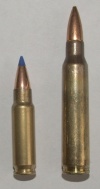
- The SS197 cartridge is currently offered to civilian shooters in addition to the SS195LF.[38] It uses the same lead core 2.6-g (40 grain) Hornady V-Max projectile as the SS196SR,[6] but it is loaded for a roughly 30-m/s (100 ft/s) higher muzzle velocity. The projectile has a blue-colored polycarbonate tip instead of the red color used in the SS196 projectile tip.[16] The SS197 is currently manufactured by Fiocchi under contract for FN Herstal[6][39] and distributed in the USA by Federal Cartridge Company.[16][38]
- SS198LF (lead free)
- The SS198 uses the same lead-free projectile and primer as the SS195LF,[34] but propels it at roughly 30-m/s (100 ft/s) higher muzzle velocity. It has a green painted tip.[16] Its sale is currently restricted by FN to law enforcement and military customers.[16]
- Non-FN ammunition
- Elite Ammunition makes a wide variety of 5.7x28mm ammunition offerings, designed for high performance.[40]
- Handloading is also possible with 5.7x28mm ammunition, using 5.7-mm (.224 in) bullets which are widely available due to use in .223 Remington and 5.56x45mm NATO cartridges.[6] Handloaders have noted that the 5.7x28mm cartridge is very sensitive.[27] Bullets weighing 2.6 g (40 grains) or less are recommended for optimal use in 5.7x28mm applications,[27] but the 1:231 mm (1:9.1 in) rifling twist rate (distance the bullet must travel to complete one full revolution) used in the firearms' barrels will stabilize bullets weighing up to 4.5 g (70 grains).[6]
[edit] Specifications
| SS190 | L191 | SS192 | SB193 | T194 | SS195LF | SS196SR | SS197SR | SS198LF | |
|---|---|---|---|---|---|---|---|---|---|
| Projectile weight | 2.0 g (31 gr) | 2.0 g (31 gr) | 1.8 g (28 gr) | 3.6 g (55 gr) | 1.8 g (28 gr) | 1.8 g (28 gr) | 2.6 g (40 gr) | 2.6 g (40 gr) | 1.8g (28 gr) |
| Muzzle velocity (P90) | 716 m/s (2,350 ft/s) | 716 m/s (2,350 ft/s) | 716 m/s (2,350 ft/s) | 305 m/s (1,000 ft/s) | 716 m/s (2,350 ft/s) | 716 m/s (2,350 ft/s) | 549 m/s (1,800 ft/s) | 594 m/s (1,950 ft/s) | — |
| Muzzle energy (P90) | 534 J (394 ft·lbf) | 534 J (394 ft·lbf) | 467 J (343 ft·lbf) | 163 J (120 ft·lbf) | 467 J (343 ft·lbf) | 467 J (343 ft·lbf) | 393 J (290 ft·lbf) | 461 J (340 ft·lbf) | — |
| Projectile type | FMJ "AP" | FMJ Tracer | JHP | FMJBT | JHP | JHP | V-Max | V-Max | JHP |
| Effective range | 200 m (655 ft) | 200 m (655 ft) | 200 m (655 ft) | 50 m (165 ft) | 200 m (655 ft) | 200 m (655 ft) | 150 m (490 ft) | 150 m (490 ft) | 200m (655 ft) |
| Color code | Plain, black or white/black | Red or red/black | Plain JHP | White/grey | Green | Plain JHP w/ silver primer | Red V-Max | Blue V-Max | Green |
| Availability | Restricted by FN | Restricted by FN | Commercial (discontinued) | Restricted by FN | Restricted by FN (discontinued) | Commercial | Commercial (discontinued) | Commercial | Restricted by FN |
Fired from the longer 40.74-cm (16.04 in) barrel of the PS90, the muzzle velocity of SS195LF is roughly 60-m/s (200 ft/s) faster, and the muzzle velocity of SS197SR is roughly 45-m/s (150 ft/s) faster.[33] Fired from the shorter 12.2-cm (4.8 in) barrel of the Five-seven pistol, the muzzle velocity of SS195LF is roughly 90-m/s (300 ft/s) slower, and the muzzle velocity of SS197SR is roughly 60-m/s (200 ft/s) slower.[33]
[edit] Controversy
In 2005, the FN Five-seven and 5.7x28mm ammunition were the subject of brief controversy in the United States when it was stated by the Brady Campaign that commercially available SS192 ammunition penetrated a Level IIA Kevlar vest in testing.[41][42] The National Rifle Association shortly countered this claim by stating that the Brady Campaign may not have adhered to standard testing procedures, and by pointing out that FN only offers armor-piercing variants of the 5.7x28mm cartridge to law enforcement and military customers.[16][42] Commercially available varieties of the 5.7x28mm cartridge are classified by the U.S. Bureau of Alcohol, Tobacco, Firearms and Explosives (ATF) as being not armor-piercing and it was stated that the SS192 and SS196 cartridge varieties did not penetrate various types of Kevlar vests in tests conducted by FNH USA.[21] In 2005, the Five-seven pistol and 5.7x28mm ammunition were specifically targeted for a United States federal ban, which failed.[43] However, sales of the pistol increased dramatically.[41]
The Five-seven and 5.7x28mm ammunition were the subject of further controversy following reports of their use by drug cartels in the "Mexican Drug War." Some reports stated that the pistol was used in various incidents to murder police officers or civilians. According to the ATF, the Five-seven is one of the weapons favored by drug cartels in the Mexican Drug War, and smuggled Five-seven pistols can sell for $2,600 to $5,000 in Mexico.[4]
In November 2009, the Five-seven and 5.7x28mm ammunition again became the subject of controversy following the pistol's reported use by U.S. Army psychiatrist, Major Nidal Malik Hasan in the Fort Hood shooting, where 13 were killed and 30 were wounded.[44] Shortly after the shooting took place, FNH USA responded with a fact sheet dismissing allegations about the nature of the pistol and 5.7x28mm sporting ammunition.[32] Later in the month, a number of gun control organizations such as the Brady Campaign wrote a collaborative letter to U.S. President Barack Obama, citing the firearm's reported use by the Fort Hood shooter and Mexican drug cartels, and calling on him to ban importation of the Five-seven pistol and 5.7x28mm ammunition.[45]
[edit] See also
- Firearms
[edit] References
- ↑ 1.0 1.1 Watters, Daniel E. "The 5.56 X 45mm Timeline: 1986-1989" The Gun Zone, June 21, 2010
- ↑ 2.0 2.1 Diez, Octavio (2000). Armament and Technology: Handguns. Barcelona: Lema Publications, S.L.. ISBN 9788484630135.
- ↑ 3.0 3.1 3.2 3.3 3.4 3.5 3.6 3.7 3.8 Watters, Daniel E.. "The 5.56 X 45mm Timeline: 1990-1994". The Gun Zone.
- ↑ Cite error: Invalid
<ref>tag; no text was provided for refs namedbyron2009 - ↑ 5.0 5.1 5.2 Miller, David (2001). The Illustrated Directory of 20th Century Guns. London: Salamander Books Ltd.. ISBN 9781840652451.
- ↑ 6.0 6.1 6.2 6.3 6.4 6.5 6.6 Forker, Bob. "The 5.7x28 FN" Guns & Ammo, May 28, 2008
- ↑ 7.00 7.01 7.02 7.03 7.04 7.05 7.06 7.07 7.08 7.09 7.10 7.11 7.12 Oliver, David. "In the Line of Fire" Global Defence Review, 2007
- ↑ New FN Herstal's Products Introduced at FIDAE, Army Technology, June 21, 2006
- ↑ Wood, J.B. "FNH USA Five-seveN Pistol 5.7×28mm" Tactical Life
- ↑ Baddeley, Adam (May 21, 2003). "NATO Delays Personal Weapon Choice". Jane's Defence Weekly - Infantry Equipment (ISSN: 02653818), p 30.
- ↑ 11.0 11.1 FN Semi-Automatic Carbines - PS90, FNH USA, 2009
- ↑ 12.0 12.1 Crane, David. "AR Five Seven (AR-57): 50-Shot 5.7x28mm AR-15 Carbine" Defense Review, August 11, 2008
- ↑ 13.0 13.1 New Models X-5.7R and X-5.7P, Excel Arms, 2010
- ↑ 14.0 14.1 Savage Arms Rifles/Shotguns: Savage 19144 25 LW Varminter-T 5.7x28 24" BBL Thumbhole Stock Blue, The Gun Source, 2010
- ↑ 15.0 15.1 Savage Arms Rifles/Shotguns: Savage 19158 25 Walking Varminter 5.7X28 24" BBL Syn/Blue The Gun Source, 2010
- ↑ 16.00 16.01 16.02 16.03 16.04 16.05 16.06 16.07 16.08 16.09 16.10 16.11 16.12 16.13 16.14 16.15 FNH USA Products — Ammunition, FNH USA, 2009
- ↑ 17.0 17.1 17.2 17.3 17.4 Marchington, James (2004). The Encyclopedia of Handheld Weapons. Miami: Lewis International, Inc.. ISBN 9781930983144.
- ↑ 18.0 18.1 18.2 18.3 18.4 Wall, Sandy (2002). "Spring 2003 Experiences with the FN P90". Hendon Publishing Co.
- ↑ Gourley, S.; Kemp, I (November 26, 2003). "The Duellists". Jane's Defence Weekly (ISSN: 02653818), Volume 40 Issue 21, pp 26-28.
- ↑ 20.0 20.1 20.2 20.3 20.4 20.5 Sterett, Larry S. (2005). "FN 5.7mm Five-seveN Pistol Makes Civilian Model Debut". Gun Week.
- ↑ 21.0 21.1 21.2 21.3 21.4 21.5 21.6 21.7 "FN 5.7 (Fabrique Nationale) Pistol is a Semiautomatic Pistol in 5.7 X 28 mm Caliber". Bureau of Alcohol, Tobacco, Firearms and Explosives. January 20, 2005.
- ↑ 22.0 22.1 22.2 "New Sporting Round from FN Herstal USA". Guns Magazine (ISSN 1044-6257), May 2005.
- ↑ 23.0 23.1 23.2 23.3 "FNH USA, Inc. 5.7x28mm Weapon System". FNH USA. 2002.
- ↑ 24.0 24.1 24.2 24.3 Detty, Mike (October 2008). "FNH 5.7x28mm Dynamic Duo". Special Weapons.
- ↑ 25.0 25.1 25.2 25.3 "Big Scale Progress for Small Arms". Global Defence Review. 2002.
- ↑ 26.0 26.1 26.2 26.3 Fortier, David (2008). "Military Ammo Today". Handguns Magazine.
- ↑ 27.0 27.1 27.2 27.3 27.4 27.5 Rodriguez, Greg (2008). "Favorite Loads: Hot Off The Press - 5.7x28mm". Shooting Times.
- ↑ Jones, Richard D.; Ness, Leland S., eds (January 27, 2009). Jane's Infantry Weapons 2009/2010 (35th ed.). Coulsdon: Jane's Information Group. ISBN 9780710628695.
- ↑ 29.0 29.1 Humphries, Michael O. (May 2008). "Radical Tactical Firepower". Tactical Weapons.
- ↑ 30.0 30.1 30.2 Bahde, Dave (November 2009). "FNH Five-seveN ODG 5.7×28mm". Combat Handguns.
- ↑ Cutshaw, Charlie (May 2006). "FN Herstal's Five-seveN Pistol". Tactical Response.
- ↑ 32.0 32.1 Five-seveN Facts, FNH USA November 09, 2009
- ↑ 33.0 33.1 33.2 FNH USA 2008 Product Catalog - 5.7x28mm Ammunition 2008
- ↑ 34.0 34.1 34.2 FNH USA 2009 Product Catalog, 2009
- ↑ 35.0 35.1 "The 5.7x28mm SS190 Ammunition". FN Herstal. 2002.
- ↑ Cutshaw, Charlie (May 2006). "FN Herstal's Five-seveN Pistol". Tactical Response.
- ↑ 37.0 37.1 37.2 37.3 37.4 "Responses to Frequently Asked Questions about 5.7x28mm Ammunition and Firearms Systems". FNH USA. 2006.
- ↑ 38.0 38.1 FNH USA 2010 Product Catalog
- ↑ "FNH USA Partners with Fiocchi". Shooting Industry (ISSN 0037-4148), January 2006.
- ↑ http://www.eliteammunition.net/5_7_ammunition.html Elite Ammunition: High Performance 5.7x28mm]
- ↑ 41.0 41.1 "Police Officers at Risk from Cop-Killer Gun," Brady Campaign, February 17, 2005
- ↑ 42.0 42.1 Lautenberg, Schumer Join Brady Campaign In Lying About the FN Five-seveN Pistol National Rifle Association Institute for Legislative Action 09, 2005
- ↑ U.S. Congressional Record - Senate S9191
- ↑ "Fort Hood Killer Reportedly Chose "Cop Killer" Handgun" Brady Campaign November 06, 2009
- ↑ "Gun Violence Prevention Organizations Call on President Obama to Use Executive Authority to Ban Import of Armor-Piercing Pistol Used in Fort Hood Attack" Violence Policy Center November 19, 2009
[edit] External links
- Official website (FNH USA)
- The 5.7x28 FN (Guns & Ammo article)
- Hot off the Press 5.7x28mm (Shooting Times article)
- FNH 5.7x28mm Dynamic Duo (Tactical Life article)
- Military Ammo Today (G&A Handguns article)
- Brassfetcher 5.7x28mm Ballistic Gelatin Tests
[edit] Video
|
|
| This article is part of a series on FN Herstal firearms | ||
|---|---|---|
| Handguns | Barracuda · Five-seven · FNP series/FNX series · Forty-Nine · Hi-Power · HP-DA · M1900 · M1903 · M1905 · M1910 | |
| Rifles | Semi-auto & select — C1 · CAL · F2000 / FS2000 · FAL · FNAR · FNC · Model 1949 · PS90 · SCAR-L/SCAR-H Bolt-action — Model 1950 · Model 30-11 · PBR · SPR · TSR | |
| Shotguns | SLP · TPS | |
| Submachine guns | P90 | |
| Machine guns | BRG-15 · M2 · MAG· Minimi · Mle 1930 | |
| Other stuff | 5.56x45mm SS109 · 5.7x28mm · EGLM · FN 303 | |
| This article is part of a series on PDWs: modern personal defense weapons and cartridges | ||
|---|---|---|
| Personal defense weapons | Colt MARS · FN P90 · Heckler & Koch MP7 · Knight's Armament Company PDW · Magpul PDR · PP-2000 · QCW-05 · Saab Bofors Dynamics CBJ-MS · ST Kinetics CPW · VBR-Belgium PDW | |
| PDW-caliber pistols | FN Five-seven · Heckler & Koch UCP · QSW-06 · QSZ-92 · VBR-Belgium CQBW | |
| PDW cartridges | 4.6x30mm · 5.56x30mm MARS · 5.56x30mm MINSAS · 5.7x28mm · 5.8x21mm DAP92 · 6x35mm KAC · 6.5x25 CBJ-MS · 7.92x24mm | |
| Handguns | M9 | M11 | MEU(SOC) | Mk 23 | Mk 24 | |
|---|---|---|
| Rifles | Assault and Battle | M16 | Mk 14 | Mk 17 |
| Carbine | HK416 | M4 | Mk 18 | |
| Designated Marksman | DMR | M14 | M39 | Mk 12 | SAM-R | SDM-R | SEAL Recon Rifle | |
| Sniper | M24 | M40 | M107 | M110 | Mk 11 | Mk 15 | |
| Shotguns | M26 | M590 | M870 | M1014 | |
| Submachine guns | MP5N | P90 | |
| Machine guns | M2HB (still!) | M240B | M249 and Mk 46 | Mk 43 | |
| Grenade launchers | M203 | M32 | M320 | M79 | Mk 19 | Mk 47 | |
| Mortars | M120 | M224 | M252 | |
| Rockets | M3 | M72 series | M136 | M141 | M202A1 | Mk 153 | |
| Missiles | FGM-172 | FGM-148 | FIM-92 | |
| Cartridges | 12-gauge | 5.7x28mm | 9x19mm NATO | .45 ACP | 5.56x45mm NATO | 7.62x51mm NATO | .50 BMG (12.7x99mm NATO) | 40x46mm | |
| This page is part of a series on: current French infantry weaponry | ||
|---|---|---|
| Handguns | PAMAS· MAC Mle 1950 | |
| Rifles | Assault rifles | FAMAS · SIG SG 550 (and variants) · HK 416 |
| Anti-materiel rifle | PGM Hecate II | |
| Sniper | FR F2 · FR F1 | |
| Shotguns | Benelli M4 | |
| Submachine guns | MP5 · P90 | |
| Machine guns | M2HB · AA52 · Minimi | |
| Grenade launchers | M203 · LGI | |
| Mortars | LLR 81mm · MO-120-RT-61 | |
| Rockets | LRAC F1 · ABL | |
| Missiles | MILAN · ERYX · Mistral | |
| Cartridges | 12-gauge · 5.7x28mm · 9x19mm NATO · 5.56x45mm NATO · 7.62x51mm NATO · 12.7x99mm NATO | |
